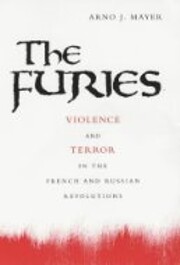

Klik op een omslag om naar Google Boeken te gaan.
|
Bezig met laden... The Furies: Violence and Terror in the French and Russian Revolutions.door Arno J. Mayer
 Geen Bezig met laden...
Meld je aan bij LibraryThing om erachter te komen of je dit boek goed zult vinden. Op dit moment geen Discussie gesprekken over dit boek.   ) )An exciting work of comparative history, this book, as its subtitle tells us, analyses the violence and terror in the two most important revolutions in history: the French 18th Century revolution and the Russian's October one. In part one, Mayer states the conceptual signposts used later on in the book (Revolution, Counterrevolution, Violence, Terror, Vengence, and Religion). Then he proceeds in the remaining four parts, with a comparative study of both revolutions (usually in a first chapter on the French, followed by another one on the Russian) analysing the events in light of the conceptual signposts of part one: the terror (both "red" and "white"), the peasent resistance (Vendée in France, the Ukraine and Tambov in Russia), the resistance of the churches, and the revolutionary wars (external in France, with Napoleon; internal in Russia, with Stalin). Overall, this is a book filled up with brilliant explanantions and insights that, in the apt words of Tariq Ali quoted in the back cover, "is the first serious attempt to answer the revisionist historians, many of whom insist on viewing the past through a prism of present-day requirements". Very impressive. geen besprekingen | voeg een bespreking toe
Prijzen
The great romance and fear of bloody revolution--strange blend of idealism and terror--have been superseded by blind faith in the bloodless expansion of human rights and global capitalism. Flying in the face of history, violence is dismissed as rare, immoral, and counterproductive. Arguing against this pervasive wishful thinking, the distinguished historian Arno J. Mayer revisits the two most tumultuous and influential revolutions of modern times: the French Revolution of 1789 and the Russian Revolution of 1917. Although these two upheavals arose in different environments, they followed similar courses. The thought and language of Enlightenment France were the glories of western civilization; those of tsarist Russia's intelligentsia were on its margins. Both revolutions began as revolts vowed to fight unreason, injustice, and inequality; both swept away old regimes and defied established religions in societies that were 85% peasant and illiterate; both entailed the terrifying return of repressed vengeance. Contrary to prevalent belief, Mayer argues, ideologies and personalities did not control events. Rather, the tide of violence overwhelmed the political actors who assumed power and were rudderless. Even the best plans could not stem the chaos that at once benefited and swallowed them. Mayer argues that we have ignored an essential part of all revolutions: the resistances to revolution, both domestic and foreign, which help fuel the spiral of terror. In his sweeping yet close comparison of the world's two transnational revolutions, Mayer follows their unfolding--from the French Declaration of the Rights of Man and the Bolshevik Declaration of the Rights of the Toiling and Exploited Masses; the escalation of the initial violence into the reign of terror of 1793-95 and of 1918-21; the dismemberment of the hegemonic churches and religion of both societies; the "externalization" of the terror through the Napoleonic wars; and its "internalization" in Soviet Russia in the form of Stalin's "Terror in One Country." Making critical use of theory, old and new, Mayer breaks through unexamined assumptions and prevailing debates about the attributes of these particular revolutions to raise broader and more disturbing questions about the nature of revolutionary violence attending new foundations. Geen bibliotheekbeschrijvingen gevonden. |
Actuele discussiesGeenPopulaire omslagen
 Google Books — Bezig met laden... Google Books — Bezig met laden...GenresDewey Decimale Classificatie (DDC)944.04History and Geography Europe France and region France Revolution 1789-1804LC-classificatieWaarderingGemiddelde: (3.9) (3.9)
Ben jij dit?Word een LibraryThing Auteur. |
||||||||||||||||||||||||||||||||||||||||||||||||||||||||||||||||||||||||||||||||||||||||||||||||||||||||||||||||||||||||